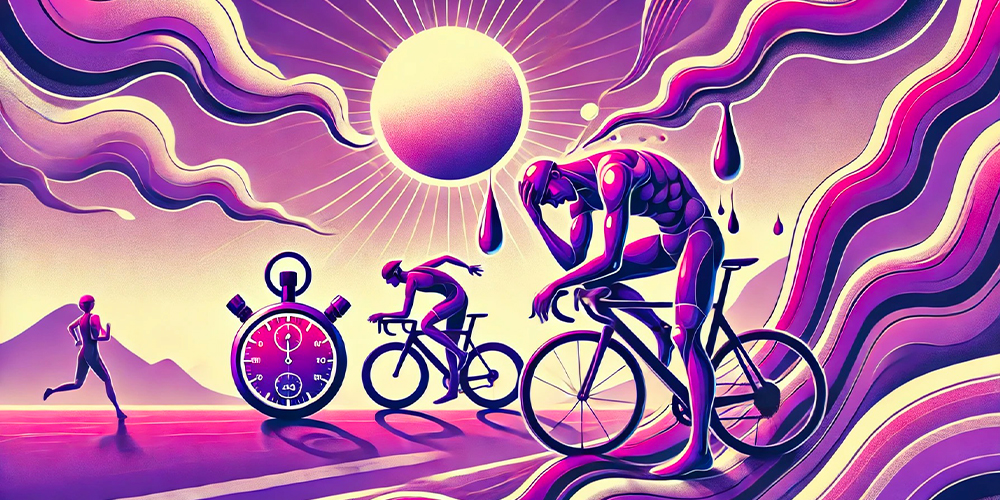Summer heat can put a significant strain on our bodies. This is because high temperatures make it harder to achieve training goals and pace targets, as we have to exert more physical effort. In this article, we’ll take a closer look at the effects of summer heat on cycling and triathlon performance.
Why do we experience a drop in athletic performance?
Heat can have a negative impact on sports performance in a number of ways:
EFFECT ON BLOOD FLOW:
Under hot conditions, our body’s blood flow is distributed differently to support energy metabolism and allow for heat dissipation. This leads to a significant reduction in blood flow to the tissues. The heart rate rises to pump more blood to the skin and remove excess heat. This extra work on the heart leads to a decrease in VO2max. As a result, the reduced blood supply negatively affects training performance.
These changes can lead to an increased sense of exertion, as the body has to put in extra effort to transport enough oxygen to the muscles. At the same time, lactic acid can accumulate more quickly, causing muscle fatigue. Decreased oxygen delivery and premature fatigue significantly impair endurance and make it more difficult to achieve training goals and performance levels.
It is estimated that heart rate is about 10-20 beats per minute higher in heat than in cooler temperatures.
INCREASED SWEATING
Heat stimulates our bodies to sweat more in order to cool down. This vital process is called “thermoregulation” and helps keep our body temperature constant. However, activating this mechanism is more difficult during the summer months due to the rise in core body temperature.
Increased sweating leads to a rapid loss of fluids and minerals that are essential for optimal body function. If these are not adequately replaced, it can impair muscle function and affect our body’s ability to effectively dissipate heat.
In intense heat, sweat production can increase 2-3 times compared to cooler conditions. In extreme situations, you can lose up to 3 liters of sweat per hour during exercise.
DEHYDRIATION
Sweating causes us to lose valuable fluids, which can lead to risks such as vomiting, muscle cramps, dizziness and collapse. It is important to adequately restore lost fluids and micronutrients to avoid such problems.
During intense physical activity in high temperatures, body weight can decrease by 2% to 6% due to sweating. As a general rule, a decrease in aerobic performance may be perceived when the decrease in body mass exceeds 2%.
LOWER COOLING CAPACITY
When the outside temperature approaches our body temperature (36.5 °C), the body’s cooling regulation is no longer as efficient as it is under cooler conditions. As a result, body temperature rises, affecting performance.
Create an AI-based triathlon and cycling training plan with 2PEAK that adapts to your performance after each workout.
Click here to download the app (iOS / Android).
How much does my performance drop?
First of all, the effects mentioned in the previous paragraph vary depending on several factors such as age, fitness, gender, actual outside temperature, humidity, heat tolerance and adaptation (very subjective).
There is no precise empirical formula for calculating the exact percentage of performance reduction. However, it is estimated that aerobic performance decreases by about 1-3% for every 1°C increase in core body temperature.
In triathlons, athletes often compete during the summer in very hot and humid locations. Even in the initial swimming section, there can be performance losses due to the heat. The increase in core body temperature is influenced by both the intensity of swimming and the water temperature. If you are swimming in water at 32ºC instead of 27ºC, this can lead to a drop in performance of between 4% and 7% in events lasting 20 to 120 minutes.
With regard to cycling, a study showed that when cyclists train in temperatures of 32ºC, their power can drop by up to 6.5%. You must be more careful when cycling, because the pleasant cooling effect produced by the wind often hides how hot it actually is and how much we are sweating.
Finally, running is the triathlon section in which there are the most drops in performance due to the heat. This is because running occurs at a slower speed than cycling, and the potential for heat loss through convection and evaporation of sweat is reduced.
How can you prevent a drop in performance?
- Listen to your body’s signals and adapt your training to the environmental conditions.
- Give your body time to adapt to the heat (about 10 days), and try to avoid training during the hottest times of the day. You can also accustom your body to the high temperatures with ‘heat acclimatisation training’, through repeated heat exposure sessions lasting between 60 and 90 minutes.
- Wear light clothing. Dress in light colours, favour ventilation on your T-shirt and helmet, get UV-filtered sunglasses and protect yourself from the sun by applying sunscreen every two hours.
- Make sure you drink enough fluids and restore micronutrients lost through sweating. Estimating your sweating rate can be helpful in understanding how much and which liquids you need to take in training and competition.
- Wet your clothes occasionally.
